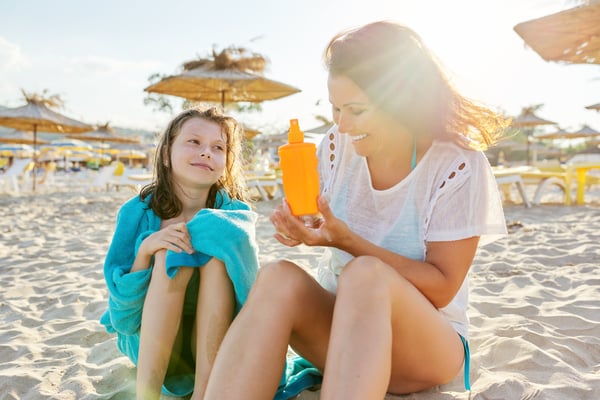Sun Smarter not Harder
Summer is here and the sun is closer and brighter. After the dark and cold Midwest winter, we all like to spend time in the sun to enjoy the new colors and get some color. Soaking up the warmth and getting the needed vitamin D is great, but being mindful of the dangers of the sun keeps your skin healthy and happy. Finding shade, wearing dark and loose clothing, a brimmed hat, and UV protective sunglasses are all great ways to protect yourself. Let’s explore another highly effective way to keep healthy and safe in the sun this summer, using sunscreen.
The sunscreen aisle at the store can be overwhelming and confusing if you are not sure what to look for. Knowing what sunscreen labels mean can help you navigate the sunscreen section like a pro. Be on the lookout for “broad spectrum.” This means the sunscreen protects against both ultraviolet A and B rays (UVA or UVB). Next, look for sun protective factor or SPF. SPF is how long it would take UVB rays to redden your skin if you applied your sunscreen as directed compared to not using any sunscreen. For example, using SPF 30 would take you 30 times longer to burn than if you applied no sunscreen.
Below is an easy guide to help you pick the best SPF for you:
- SPF 15: Daily use for short spurts of time outside
- SPF 30+: For extended time outside
- SPF 50-70: If you burn easily, or have photosensitivity due to medication or a disorder
Another label term to know is “mineral” or “chemical” sunscreen. Mineral sunscreens provide a physical barrier for protection by blocking and scattering UV rays. Chemical sunscreens absorb UV rays. There are also many different sunscreens available based on different skin types. Whether your skin is oily, dry, or sensitive, there is a sunscreen to keep you protected.
Rules of Thumb
- Apply sunscreen 30 minutes prior to going outside, and reapply if you are sweating and dry off
- Apply 30 minutes before swimming and reapply after you get out of the water and dry off
- Check the label for water resistance
- Water resistant is effective for at least 40 minutes of swimming
- Very water resistant is effective for 80 minutes of swimming
- Do not rely on makeup with SPF since it only covers where it is applied and typically is not reapplied every two hours as recommended for the best protection
- Check the expiration date on your sunscreen and if you cannot find one, replace it after a maximum of three years
- Do not keep your sunscreen in your car where temperatures are high and fluctuate, ruining SPF
- Avoid direct sun exposure during peak sun hours between 10:00 a.m. and 4:00 p.m.
SNEAK PEEK
Take pleasure in this preview of our popular Good Talk series. Delve into the world of summer skin care as we explore the intricacies and essentials of SPF in our episode titled “Sun Smart.”



